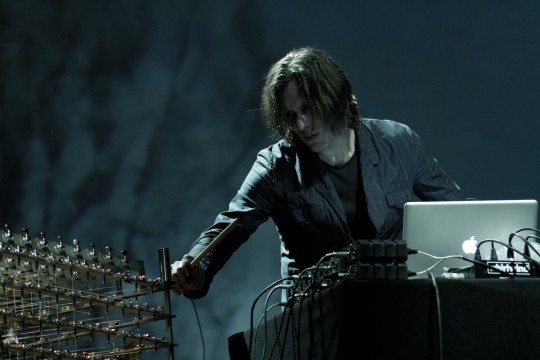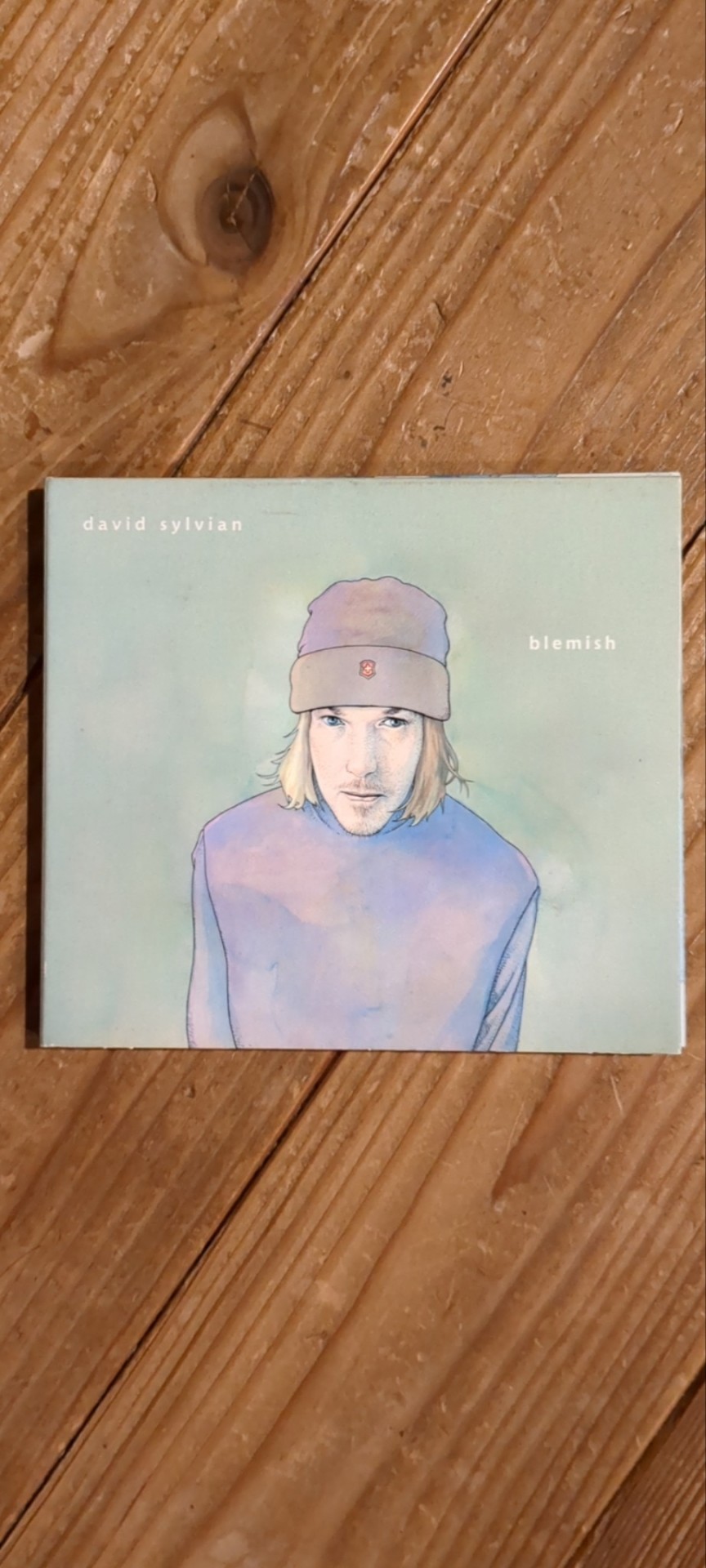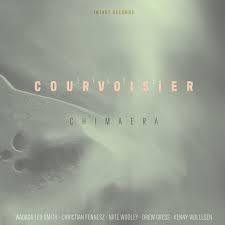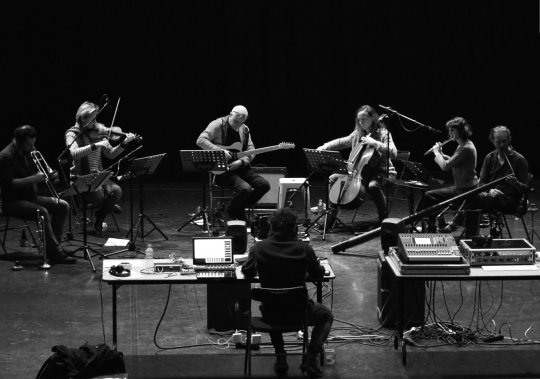#christian fennesz
Text
Sylvie Courvoisier — Chimaera (Intakt)

Duration can be a double-edged sword. When it’s handled wrong, longer-form music can just feel long. And in an age when a preponderance of music is served up in three or four minute-long bites, a tune doesn’t need to be too long to feel like a bit of a chew. But duration can justify itself by allowing a listener to untether the listening experience from recognizing structural elements and marking their repetitions. That’s certainly the case with the music on Chimaera, the debut album by a combo led by Sylvie Courvoisier that bears the same name.
Chimaera is an outgrowth of Courvoisier’s trio with bassist Drew Gress and drummer Kenny Wolleson. To their number she added Nate Wooley, who brings a deep bag of extended trumpet techniques and an even deeper interrogative spirit, and Christian Fennesz, whose application of electronics can transform the sound of his guitar beyond recognition. And for this session, she added another trumpeter, Wadada Leo Smith.
One might expect a band named after a fire-breathing, two-headed beast to singe some ear hairs, but that’s not really the case. It’s more likely that the Swiss-born pianist and composer, who has been based in Brooklyn since the late 1990s, chose it for its mythological dimension. The album’s compositions were inspired by the paintings of Odilon Redon, a direct predecessor of surrealism. Their length permits the listener to be simply be present as the music manifests in diaphanous layers of color and forms that are perceptible, but not always recognizable. Gress begins “Le Pavot Rouge,” the album’s opening track, with a questioning, bluesy figure introduction. In short order, he parts a veil of shimmering piano and vibraphone (Wollesen plays vibraphone as drum kit much of the time, which substantially shifts the weight and character of sound away from piano trio conventions), and then takes up a spare, abstracted tango rhythm. Over the next 20 minutes, musicians enter and exit the action. One trumpet takes up the querying vibe, and the other resolves it. The guitar floats dubby echoes over the pulse. Courvoisier darts out of the vibes at double speed, or complicates some brass harmonies with spare dissonant notes.
In other settings, such as her duo with Mary Halvorson, Courvoisier favors abruptness and density. Chimaera’s music is no less eventful. But it drifts instead of bursting, inviting the listener to surrender to a sequence of dissolutions, reconstitutions, and surprising elaborations across six compositions and 87 minutes of dream-like music.
Bill Meyer
#sylvia courvoisier#chimaera#intakt#bill meyer#albumreview#dusted magazine#drew gress#kelly wolleson#wadada leo smith#christian fennesz#nate wooley#odilon redon#jazz
4 notes
·
View notes
Text

Christian Fennesz
source: blackrhinoradio
📸: Luis Martins
5 notes
·
View notes
Audio
Listen/purchase: Le pavot rouge by SYLVIE COURVOISIER feat. Wadada Leo Smith, Christian Fennesz, D. Gress, N. Wooley, K. Wollesen
#jazz#sylvie courvoisier#wadada leo smith#christian fennesz#nate wooley#drew gress#kenny wollesen#bandcamp#music
4 notes
·
View notes
Text
Fennesz Sakamoto - haru
10 notes
·
View notes
Photo


"(...) A future's hinting at itself
Do you fear what I fear?
All those names of ancestry
Too gentle for the stones they bear
Somewhere someone wants to see you
Someone's traveling towards us all
You might also like
To wonder why of Europe
To live, love, and cry in Europe
Say your goodbyes to Europe
Our history dies with Europe (...)"
Christian Fennesz, David Sylvian, "Transit" (album "Venice", 2004)
youtube
#mikopol#watercolor#aquarelle#traditional art#europe#poland#poznan#railroad#railway#railway station#cat#kot#neko#travel#Journey#trip#tourist#ambient#christian fennesz#melancholy#train#en57#Retro#urban
11 notes
·
View notes
Text
youtube
A couple of electronic musicians used the period of noughts in order to find what makes them and they prospered. Well, the recently departed Sakamoto was a great case of that, though you do know by now I am a huge fan of his, so me calling him as someone who kept doing an incredible work til the end might be a fanboy in me speakin. Nonetheless, we can agree he did stretch himself successfully more often than a majority of his peers. For instance, what he and Fennesz did on their two albums during the noughts, especially on Cendre, remains enigmatic to discuss. I call their cooperation an uneasy ambient and I still stand by this term, since they do traverse the landscape of the genre, but they don't have any map. They collide towards each other in hope of getting somewhere better.
1 note
·
View note
Text

david sylvian
blemish
0 notes
Text
Sylvie Courvoisier - Chimaera
“The lucid, dreamlike sounds of Courvoisier’s Chimaera album are floating and elusive like shadows on the ocean; the melodic glitter of trumpet, piano and vibraphone on a rolling groove of rhythmic ambience, with Fennesz’s magical guitar clouds enveloping the band,”
Bradley Bamberger
Nata a Losanna, in Svizzera, Sylvie ha studiato al Conservatorio di Montreux e a Losanna, pianoforte,…

View On WordPress
0 notes
Text
Christian Fennesz & Ryuichi Sakamoto- Abyss
1 note
·
View note
Text
youtube
Sad music for sad days... 😪
0 notes
Text





mike's smooshable nose collection is still a thing yall
Mike Patton with Christian Fennesz at Moers Festival 2007
photo by Sven Thielmann
#mike patton#ugh i just love this set a whole heckin lot#ok goodnight#whoever called me an archivist - i'm honored to serve#patton and fennesz
15 notes
·
View notes
Audio
Listen/purchase: Chimaera (24bit Hi-Res 96khz) by SYLVIE COURVOISIER feat. Wadada Leo Smith, Christian Fennesz, D. Gress, N. Wooley, K. Wollesen
2 notes
·
View notes
Text
Ensemble Dedalus & ErikM — Fata Morgana (Relative Pitch)

Fata Morgana by Ensemble Dedalus + eRikm
Fata Morgana takes its name from a mirage phenomenon that has seriously messed with the minds of polar, nautical and desert travelers. The funhouse mirror-like effect occurs when layers of warm and cold air bend light rays, resulting in images that appear to be suspended, inverted or otherwise distorted above the horizon. The title of this CD-length musical piece provides insight into how its composer, French electronic musician ErikM, understands its generative process.
ErikM is a bit of a navigator himself. He’s operated across a spectrum that spans improvised adventures with figures such as Isabelle Duthoit, Christian Fennesz, and Anthony Pateras, and labor-intensive sound constructions. Fata Morgana joins both ends of the continuum. The initial spark derives from ErikM’s collection of natural sounds, sourced from bats and aquatic creatures, that are normally inaudible to humans. He amplified and played them to the musicians of Ensemble Dedalus, a new music group from Toulouse, France, that has realized the music of Eliane Radigue, Pascale Criton and Moondog. They mimicked and otherwise reacted to this material, and their responses begat scores, which the ensemble then performed in real time with ErikM. Recordings of the played music was then edited and re-composed, resulting in the recording under consideration.
By now, some readers might be wondering why an electroacoustic composition by established European practitioners has been released on an American label that specializes in disseminating the work of new improvisers, as well as some established jazz veterans (Tim Berne, Ingrid Laubrock, Tom Rainey) who have NY zip codes. Perhaps because the music draws upon a common vocabulary of extended instrumental techniques? Fata Morgana sings a siren song to ears that are tuned into tart string snaps, brass growls and abraded timbres, which mix appositely with the naturally sourced high frequencies heard early in the piece.
But the post-performance rearrangement of these sounds leads to an unfolding that may be episodic, but quite different from the accumulations and attenuations of events that one might associated with a free improvisation. One gets the impression that sounds are arranged so that a listener will focus on events as they happen. Instead of transpiring in some narrative fashion, the music’s developments have been embedded within the sounds. While the album’s liner notes refer to “tangled trails,” a sound traveler could obtain plenty of satisfaction from being dropped in helicopter fashion in and out of the music. Put more prosaically, don’t be afraid to listen a track at a time, or using shuffle play.
Bill Meyer
#ensemble dedalus#erikm#fata morgana#relative pitch#bill meyer#album review#dusted magazine#electroacoustic composition
2 notes
·
View notes
Text
Fennesz Announces New Album With Ozmotic, Shares Song: Listen
“Floating Time” leads the album Senzatempo, which follows Christian Fennesz’s 2015 collaboration with the Turin duo, AirEffect
from RSS: News https://ift.tt/HLKkvEU
0 notes
Text
Fennesz Announces New Album With Ozmotic, Shares Song: Listen
“Floating Time” leads the album Senzatempo, which follows Christian Fennesz’s 2015 collaboration with the Turin duo, AirEffect
from RSS: News https://ift.tt/J5m6xyo
via IFTTT
0 notes
